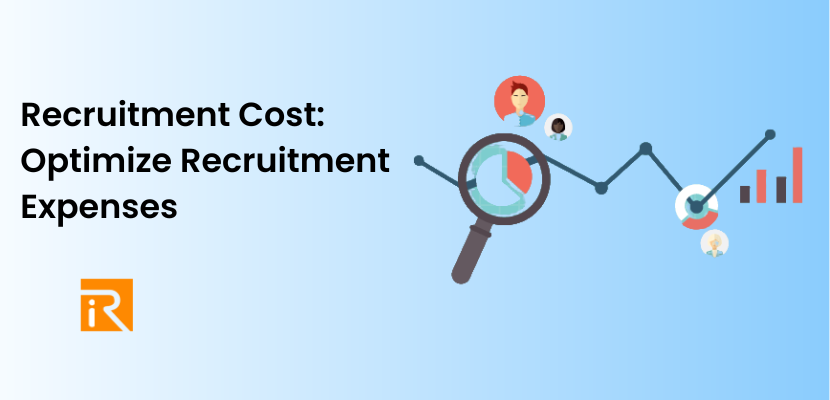Recruitment Cost is a significant concern for businesses of all sizes. It encompasses the expenses associated with finding, attracting, and hiring new talent.
As per the Society for Human Resource Management (SHRM), the average cost to hire an employee in the USA stands at approximately $4,700.
Nevertheless, numerous employers estimate that the overall expense of bringing a new employee on board can range from three to four times the salary associated with the position.
Whether you run a small startup or a large corporation, understanding and optimizing your recruitment costs can positively impact your bottom line.
In this blog, we will delve into recruitment costs, their components, and strategies to minimize them.
Understanding Recruitment Cost
Recruitment costs neatly fall into two distinct categories: Direct Costs and Indirect Costs.
Among these expenses, approximately 30 percent to 40 percent constitute hard costs, while the remaining 60 percent encompass soft costs.
Soft costs encompass the valuable time and resources that departmental leaders and managers dedicate to supporting the HR-specific aspects of the hiring process. So, when these soft costs are combined with the hard costs, the overall recruitment expenditure experiences a significant surge.
Direct Costs
-
Job Postings
Funds are allocated for advertising job vacancies on various platforms.
-
Background Checks
Expenses incurred while verifying candidates’ backgrounds and qualifications.
-
Recruiter Salaries
Compensation for the skilled professionals dedicated to the hiring process.
Indirect Costs
-
Reduced Productivity
The subtle but impactful dip in overall productivity as current employees divert time and effort to assist with the recruitment process.
-
Onboarding Expenses
Costs associated with the orientation and training of new hires, including materials and training programs.
Understanding these cost divisions empowers organizations to make informed decisions and optimize their recruitment strategies for efficiency and cost-effectiveness.
Precise Calculation of Recruitment Costs
In order to gain a comprehensive understanding of your recruitment expenditures, meticulous identification of all cost components is paramount. These components encompass various facets, such as advertising expenses, interview-related travel costs, and software subscription fees.
The formula for calculating recruitment costs is refreshingly straightforward:
Recruitment Cost = Total Direct Costs + Total Indirect Costs.
By adhering to this systematic approach, organizations can meticulously quantify their recruitment expenses, facilitating data-driven decision-making and resource optimization.
Strategies to Reduce Recruitment Costs
Implementing these strategies will not only help reduce recruitment cost but also enhance the overall effectiveness of your hiring processes, ensuring a cost-efficient and talent-rich workforce.
Effective Job Descriptions
Craft precise, compelling job descriptions with clear expectations and benefits to attract well-matched candidates, reducing time spent on unsuitable applicants.
Leverage Employee Referrals
Encourage staff to refer candidates from their professional networks, a cost-effective method often leading to candidates who align with the company’s culture and values.
Streamline Interviews
Reduce the number of interview rounds, involve only key decision-makers, and employ video interviews to minimize travel costs and hasten the selection process.
Embrace Technology
Invest in modern applicant tracking systems (ATS) and AI-driven tools to automate resume screening, candidate communication, and scheduling, significantly expediting the hiring process and cutting costs.
Outsource When Needed
Consider outsourcing aspects like initial candidate sourcing, background checks, or reference checks to specialized agencies or freelancers. Additionally, it provides flexibility and cost-efficiency without increasing in-house overheads.
Data-Driven Decision-Making
Utilize recruitment analytics to identify bottlenecks and inefficiencies in the hiring process. Therefore, allowing for targeted improvements that save time and money.
Internal Training Programs
Develop internal training programs to upskill existing employees for potential role transitions. Therefore, it will reduce the need for external hires and associated recruitment costs.
Continuous Improvement
Regularly review and refine your recruitment processes to identify areas where cost-saving measures can be implemented without compromising the quality of hires.
Measuring Recruitment ROI: A Vital Assessment
Comprehending the Return on Investment (ROI) of your recruitment endeavors is paramount. To ascertain ROI, deduct your total recruitment expenses from the value the new hire contributes to your organization.
A positive ROI signifies that your recruitment strategy effectively acquires talent in a cost-efficient manner. Additionally, this metric not only gauges the financial impact but also the overall efficacy of your recruitment efforts.
Therefore, measuring ROI empowers organizations to make informed decisions, optimize their hiring strategies, and ensure the alignment of recruitment goals with business objectives.
Conclusion
Consequently, recruitment cost is a substantial part of any business’s budget. By adopting cost-saving strategies you can minimize these expenses. Such as optimizing job descriptions, leveraging employee referrals, streamlining interviews, embracing technology, and measuring ROI.
Therefore, in the long run, efficient recruitment is very beneficial. It not only saves money but also contributes to the growth and success of your organization.






















